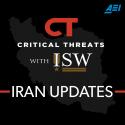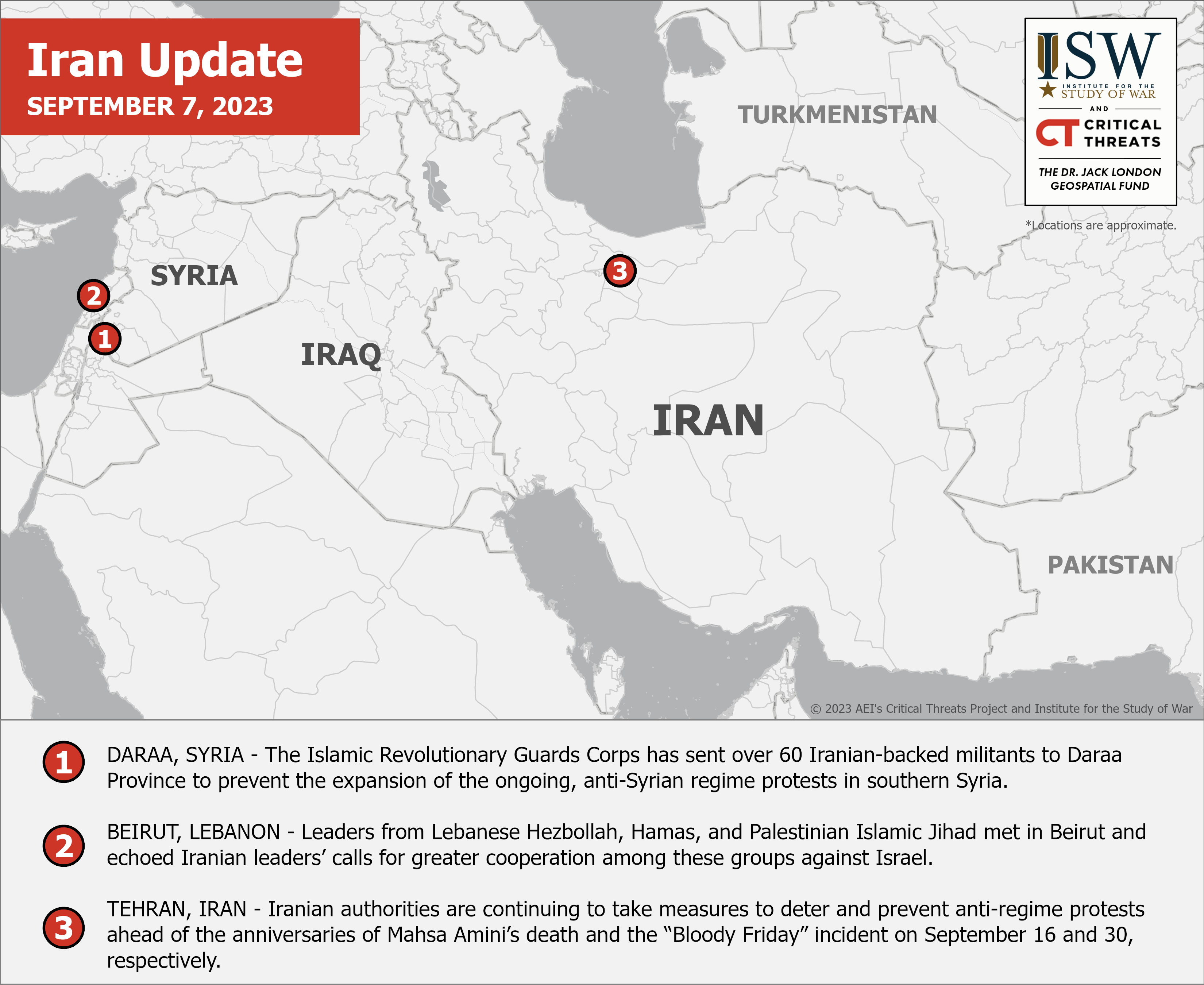 |
 |
Iran Update, September 7, 2023

Iran Update, September 7, 2023
Andie Parry, Annika Ganzeveld, and Nicholas Carl
The Iran Update aims to inform national security policy by providing timely, relevant, and independent open-source analysis of developments pertaining to Iran and its Axis of Resistance. This update covers political, military, and economic events and trends that affect the stability and decision-making of the Iranian regime. It also provides insights into Iranian and Iranian-sponsored activities abroad that undermine regional stability and threaten US forces and interests. The Critical Threats Project (CTP) at the American Enterprise Institute with support from the Institute for the Study of War (ISW) provides these updates Monday through Friday. To receive Iran Updates via email, please subscribe here.
The Institute for the Study of War (ISW) with support from the Critical Threats Project (CTP) at the American Enterprise Institute launched an interactive map of Iran and the Middle East. The map depicts events in Iran that affect the stability of the Iranian regime, namely anti-regime protests and reported poisoning incidents. It also shows developments in Syria that jeopardize regional stability and pose threats to US forces and interests, including Iranian and Iranian-backed militia positions.
Key Takeaways
- The Islamic Revolutionary Guards Corps has sent over 60 Iranian-backed militants to Daraa Province to prevent the expansion of the ongoing, anti-Syrian regime protests in southern Syria.
- Leaders from Lebanese Hezbollah, Hamas, and Palestinian Islamic Jihad met in Beirut and echoed Iranian leaders’ calls for greater cooperation among these groups against Israel.
- Iranian authorities are continuing to take measures to deter and prevent anti-regime protests ahead of the anniversaries of Mahsa Amini’s death and the “Bloody Friday” incident on September 16 and 30, respectively.
Iranian Activities in the Levant
This section covers Iranian efforts to consolidate and expand Tehran’s economic, military, and political influence throughout the Levant especially in Syria. This section examines some of the many campaigns that Iran is pursuing to achieve this strategic objective. CTP will update and refine our assessments of these campaigns over time and in future updates.
The Islamic Revolutionary Guards Corps has sent over 60 Iranian-backed militants to Daraa Province to prevent the expansion of the ongoing, anti-Syrian regime protests in southern Syria.[1] The militants include Iraqi, Lebanese, and Syrian fighters and are operating under Lebanese Hezbollah (LH) and the Iranian-backed Syrian Arab Army 4th Division, according to Syrian opposition reports on September 7. The militants will reportedly cooperate with the 4th Division to stoke instability in Daraa and Suwayda provinces and blame ISIS, which would provide the regime a pretext for a harsher crackdown on demonstrators. These reports came as separate opposition reports claimed that Syrian regime military and security officers met in Daraa City to discuss how to control the anti-regime protests that have fluctuated throughout Syria since mid-August 2023. The reports that the IRGC is cooperating with the Bashar al Assad regime to impose social control is consistent with ISW’s previous reporting that Iranian-backed snipers deployed to southern Syria twice in late August 2023, likely to deter and prevent the expansion of protests.[2]
Leaders from LH, Hamas, and Palestinian Islamic Jihad (PIJ) met in Beirut and echoed Iranian leaders’ calls for greater cooperation among these groups against Israel. The meeting occurred on September 2 and included LH Secretary General Hassan Nasrallah, Hamas deputy head Saleh al Arouri, and PIJ head Ziyad al Nakhalah.[3] This meeting is especially noteworthy given how rare such meetings between all three figures are. Hamas and PIJ leadership similarly met in Gaza in August 2023 to discuss enhancing cooperation against Israel.[4] These meetings come as Iranian leaders have increasingly emphasized the importance of greater cohesion and unity across the resistance groups opposing Israel.[5]
Iranian Domestic and Political Affairs
This section covers factors and trends affecting regime decision-making and stability. CTP will cover domestic politics, significant protest activity, and related issues here.
Iranian authorities are continuing to take measures to deter and prevent anti-regime protests ahead of the anniversaries of Mahsa Amini’s death and the “Bloody Friday” incident on September 16 and 30, respectively. Protest coordinators and organizations have planned demonstrations in the coming weeks, as CTP previously reported.[6]
- Iranian intelligence services announced the arrest of a network of protest planners on September 7.[7] The regime similarly arrested a group of women’s rights activists on August 17 for planning to “incite chaos and vandalism” on the anniversary of Mahsa Amini’s death.[8]
- The regime is planning outreach to Iran’s Sunni minority community likely to reduce the risk of major unrest in the eastern Iranian provinces. Supreme Leader Ali Khamenei will meet with residents from Sistan and Baluchistan and South Khorasan provinces on September 11.[9] Demonstrations against the regime have occurred weekly in Sistan and Baluchistan Province since regime security forces violently suppressed protesters in Zahedan in September 2022 in an event that became known as “Bloody Friday.”[10]
[1] https://eyeofeuphrates dot com/ar/news/2023/09/07/9616
[2] https://eyeofeuphrates dot com/ar/news/2023/08/28/9537 ; https://eyeofeuphrates dot com/ar/news/2023/08/31/9557
[7] https://www.irna dot ir/news/85222021
[8] https://www.tasnimnews dot com/fa/news/1402/05/26/2942428
[9] https://www.irna dot ir/news/85221118 ;
https://www.irna dot ir/news/85222439
